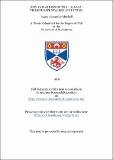New variations of the 1, 6, 6aλ⁴-triheterapentalene structure
Abstract
The reaction between 3-substituted-5-phenyl-1, 2-dithiolium salts and various aminoheterocycles was investigated. Substituted 2-aminopyridines gave, in most cases, a mixture of two isomeric products, formulated as dithiadiazacyclopent [a] indenes. Similarly, 2-amino-2-thiazoline and 2-aminothiazole gave a mixture of products. The effect of using different solvents and leaving groups in these reactions was studied. 4-Aminopyridine, 2-aminopyrimidine and 2-aminobenzimidazole each gave only one product, whereas 2,6-diaminopyridine produced a mixture of two disubstitution products- N-Phenylbenzamidine gave a small quantity of 5-phenyl-3-phenylimino- 3H-1, 2-dithiole, while 2-methylpyridine produced no useful material. Two byproducts, 5-phenyl-1, 2-dithiole-3-thione and 5-phenyl-1, 2- dithiole-3-one were formed in each reaction which was investigated. 2-Amino-4-methylpyridine reacted with perchloromethyl mercaptan to give a sulphenamide. Reaction of this compound with benzoylacetic acid, followed by thionation, provided an alternative route to one of the dithiadiazacyclopent [a] indene isomers. The sulphenamides of 2-amino-2-thiazoline and 2-aminothiazole failed to react with benzoylacetic acid. 1, 2, 4-Thiadiazoles were used to synthesise compounds formulated as 1H- and 6H-triheterapentalenes. 4, 5-Dihydro-5-imino-1, 2, 4-thiadiazoles reacted with arenediazonium fluoroborates to give 6H-3aλ⁴ -thia-1, 2, 3, 4 , 6-pentaazapentalehes. 4, 5-Dihydro-5-imino - 1,2,4-thiadiazoles formed Vilsmeier salts which reacted with aqueous methylamine or sodium hydrogen sulphide solution, producing 1H-3aλ⁴ thia-1,3,4,6-tetraazapentalenes and 6H-3, 3aλ⁴ -dithia-1, 4 , 6-triazapentalenes respectively. Sodium hydroxide and sodium hydrogen selenide solutions failed to react with these Vilsmeier salts. 6H-3-oxa-3aλ⁴ -thia-1, 4, 6-triazapentalenes were prepared from 5-acetamino-3-methyl-1, 2, 4 -thiadiazole, 5-formamino- 3-methyl- 1, 2, 4 - thiadiazole,3,6-dimethyl-5-methyl- thio-6H-3aλ⁴ -thia-1, 3, 4, 6-tetraazapentalene and from 4, 5-dihydro- 5-imino- 3, 4 - dimethyl-1, 2, 4 - thiadiazole. 6H-3, 3aλ⁴ -Dithia-1,4,6-triazapentalenes were prepared by thionating oxathiaazapentalenes, and by allowing carbon disulphide to react with 1, 2, 4-thiadiazolium salts. An attempted synthesis of 5,6-dimethyl-6H-3, 3aλ⁴ -dithia- 1, 2, 4 , 6-tetraazapentalene from 5-amino-3, 4-dimethyl-4H-1, 2, 4- thiadiazolium iodide proved unsuccessful. 4, 5-Dihydro-5-imino-3,4-dimethyl- 1, 2, 4-thiadiazole reacted with phenylisocyanate giving 2-aminophenyl-5, 6-dimethyl- 6H-3-oxa-3aλ4-thia-1, 4 , 6-triazapentalene. Phenylisothiocyanate gave 2-aminophenyl-5, 6-dimethyl-6H-3, 3aλ4-dithia-1, 4 , 6-triaza- pentalene. Thiophosgene gave 1, 3-bis(3, 4-dimethyl-1, 2, 4- thiadiazol-5-ylidene)acetone.
Type
Thesis, PhD Doctor of Philosophy
Collections
Items in the St Andrews Research Repository are protected by copyright, with all rights reserved, unless otherwise indicated.

